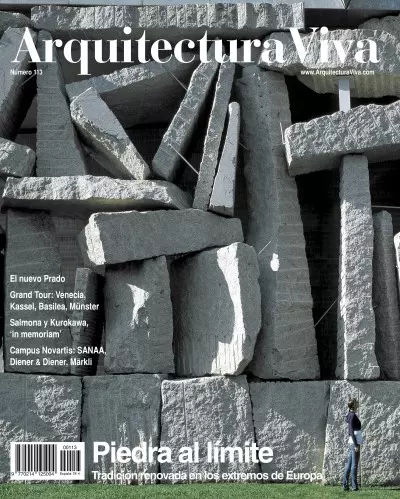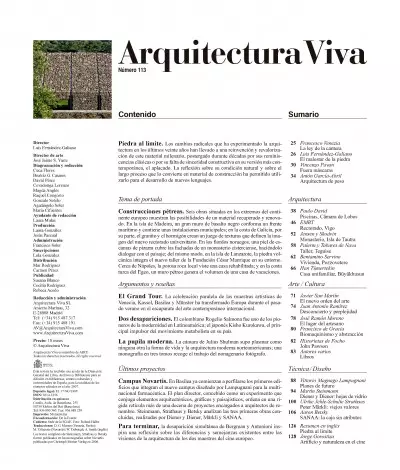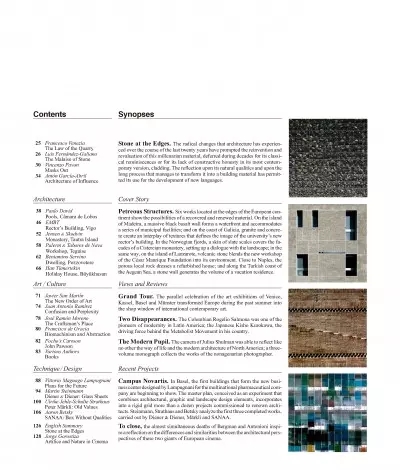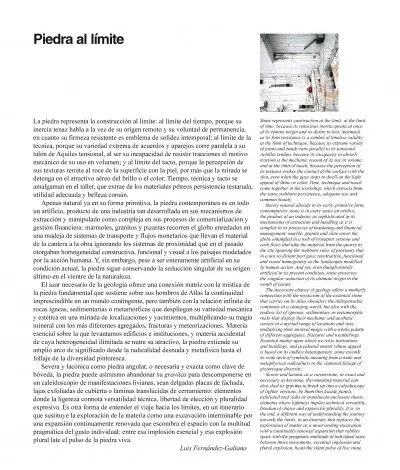Synopses
Stone at the Edges. The radical changes that architecture has experienced over the course of the last twenty years have prompted the reinvention and revaluation of this millenarian material, deferred during decades for its classical reminiscences or for its lack of constructive honesty in its most contemporary version, cladding. The reflection upon its natural qualities and upon the long process that manages to transform it into a building material has permitted its use for the development of new languages.
Contents
Francesco Venezia
The Law of the Quarry
Luis Fernández-Galiano
The Malaise of Stone
Vincenzo Pavan
Masks Out
Antón García-Abril
Architecture of Influence
Architecture
Petreous Structures. Six works located at the edges of the European continent show the possibilities of a recovered and renewed material. On the island of Madeira, a massive black basalt wall forms a waterfront and accommodates a series of municipal facilities; and on the coast of Galicia, granite and concrete create an interplay of textures that defines the image of the university’s new rector’s building. In the Norwegian fjords, a skin of slate scales covers the facades of a Cistercian monastery, setting up a dialogue with the landscape; in the same way, on the island of Lanzarote, volcanic stone blends the new workshop of the César Manrique Foundation into its environment. Close to Naples, the porous local rock dresses a refurbished house; and along the Turkish coast of the Aegean Sea, a stone wall generates the volume of a vacation residence.
Cover Story
Paulo David
Pools, Câmara de Lobos
EMBT
Rector’s Building, Vigo
Jensen & Skodvin
Monastery, Tautra Island
Palerm & Tabares de Nava
Workshop, Teguise
Beniamino Servino
Dwelling, Pozzovetere
Han Tümertekin
Holiday House, Büyükhusun
Views and Reviews
Grand Tour. The parallel celebration of the art exhibitions of Venice, Kassel, Basel and Münster transformed Europe during the past summer into the shop window of international contemporary art.
Art / Culture
Javier San Martín
The New Order of Art
Juan Antonio Ramírez
Confusion and Perplexity
Two Disappearances. The Colombian Rogelio Salmona was one of the pioneers of modernity in Latin America; the Japanese Kisho Kurokawa, the driving force behind the Metabolist Movement in his country.José Ramón Moreno
The Craftsman’s Place
Francisco de Gracia
Biomachinism and Abstraction
The Modern Pupil. The camera of Julius Shulman was able to reflect like no other the way of life and the modern architecture of North America; a three-volume monograph collects the works of the nonagenarian photographer.Focho’s Cartoon
John Pawson
Various Authors
Books
Recent Projects
Campus Novartis. In Basel, the first buildings that form the new business center designed by Lampugnani for the multinational pharmaceutical company are beginning to show. The master plan, conceived as an experiment that combines architectural, graphic and landscape design elements, incorporates into a rigid grid more than a dozen projects commissioned to renown architects. Steinmann, Strathaus and Betsky analyze the first three completed works, carried out by Diener & Diener, Märkli and SANAA.
Technique / Style
Vittorio Magnago Lampugnani
Plans for the Future
Martin Steinmann
Diener & Diener: Glass Sheets
Ulrike Jehle-Schulte Strathaus
Peter Märkli: Old Values
Aaron Betsky
SANAA: Box Without Qualities
To close, the almost simultaneous deaths of Bergman and Antonioni inspire a reflection on the differences and similarities between the architectural perspectives of these two giants of European cinema.English Summary
Stone at the Edges
Jorge Gorostiza
Artifice and Nature in Cinema
Luis Fernández-Galiano
Stone at the Edges
Stone represents construction at the limit: at the limit of time, because its tenacious inertia speaks at once of its remote origin and its desire to last, inasmuch as its firm resistance is a symbol of timeless solidity; at the limit of technique, because its extreme variety of joints and bonds runs parallel to its tensional Achilles tendon, because its incapacity to absorb traction is the mechanic reason of its use in volume; and at the limit of touch, because the perception of its textures evokes the contact of the surface with the skin, even when the gaze stops to dwell on the light appeal of shine or color. Time, technique and touch come together in the workshop, which extracts from the stone stubborn persistence, adequate use and common beauty.
Barely natural already in its early, primitive form, contemporary stone is in every sense an artifice, the product of an industry as sophisticated in its mechanisms of extraction and handling as it is complex in its processes of marketing and financial management: marble, granite and slate cover the globe entangled in a web of transport systems and cash flows that take the material from the quarry to the site ignoring the stubborn rules of proximity that in a not so distant past gave constructive, functional and visual homogeneity to the landscapes modelled by human action. And yet, even though entirely artificial in its present condition, stone preserves the singular seduction of its ultimate origin in the womb of nature.
The necessary chance of geology offers a motherly connection with the mysticism of the essential stone that carries on its Atlas shoulders the indispensable continuity in a changing world, but also with the endless list of igneous, sedimentary or metamorphic rocks that display their mechanic and aesthetic variety in a myriad range of locations and sites, multiplying their mineral magic with a whole palette of different aggregates, fractures and weatherings. Essential matter upon which we raise institutions and buildings, and accidental matter whose appeal is based on its endless heterogeneity, stone extends its wide arch of symbolic meaning from a nude and metaphysical radicalness to the cluttered foliage of picturesque diversity.
Severe and laconic as a cornerstone, or exact and necessary as keystone, this mutating material can also shed its gravitas to break up into a caleidoscope of lighter versions, be them thin facade panels, exfoliated roof slabs or translucent enclosure sheets: elements where lightness implies technical versatility, freedom of choice and expressive plurality. It is, in the end, a different way of understanding the journey towards the limits, in an itinerary that replaces the exploration of matter as a never-ending excavation with a continually renewed expansion that rubbles space with the pragmatic multitude of individual taste: between those movements, essential implosion and plural explosion, beats the silent pulse of live stone.








